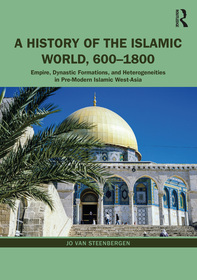
A History of the Islamic World, 600-1800
Empire, Dynastic Formations, and Heterogeneities in Pre-Modern Islamic West-Asia
-
20% KEDVEZMÉNY?
- A kedvezmény csak az 'Értesítés a kedvenc témákról' hírlevelünk címzettjeinek rendeléseire érvényes.
- Kiadói listaár GBP 38.99
-
18 627 Ft (17 740 Ft + 5% áfa)
Az ár azért becsült, mert a rendelés pillanatában nem lehet pontosan tudni, hogy a beérkezéskor milyen lesz a forint árfolyama az adott termék eredeti devizájához képest. Ha a forint romlana, kissé többet, ha javulna, kissé kevesebbet kell majd fizetnie.
- Kedvezmény(ek) 20% (cc. 3 725 Ft off)
- Kedvezményes ár 14 902 Ft (14 192 Ft + 5% áfa)
Iratkozzon fel most és részesüljön kedvezőbb árainkból!
Feliratkozom
18 627 Ft

Beszerezhetőség
Becsült beszerzési idő: A Prosperónál jelenleg nincsen raktáron, de a kiadónál igen. Beszerzés kb. 3-5 hét..
A Prosperónál jelenleg nincsen raktáron.
Why don't you give exact delivery time?
A beszerzés időigényét az eddigi tapasztalatokra alapozva adjuk meg. Azért becsült, mert a terméket külföldről hozzuk be, így a kiadó kiszolgálásának pillanatnyi gyorsaságától is függ. A megadottnál gyorsabb és lassabb szállítás is elképzelhető, de mindent megteszünk, hogy Ön a lehető leghamarabb jusson hozzá a termékhez.
A termék adatai:
- Kiadás sorszáma 1
- Kiadó Routledge
- Megjelenés dátuma 2020. augusztus 12.
- ISBN 9780415660327
- Kötéstípus Puhakötés
- Terjedelem448 oldal
- Méret 246x174 mm
- Súly 890 g
- Nyelv angol
- Illusztrációk 107 Illustrations, black & white; 82 Halftones, black & white; 12 Line drawings, black & white; 13 Tables, black & white 86
Kategóriák
Rövid leírás:
A History of the Islamic World, 600-1800 supplies a fresh and unique survey of the formation of the Islamic world and the key developments that characterize this broad region’s history from late antiquity up to the beginning of the modern era.
TöbbHosszú leírás:
A History of the Islamic World, 600–1800 supplies a fresh and unique survey of the formation of the Islamic world and the key developments that characterize this broad region’s history from late antiquity up to the beginning of the modern era.
Containing two chronological parts and fourteen chapters, this impressive overview explains how different tides in Islamic history washed ashore diverse sets of leadership groups, multiple practices of power and authority, and dynamic imperial and dynastic discourses in a theocratic age. A text that transcends many of today’s popular stereotypes of the premodern Islamic past, the volume takes a holistically and theoretically informed approach for understanding, interpreting, and teaching premodern history of Islamic West-Asia. Jo Van Steenbergen identifies the Asian connectedness of the sociocultural landscapes between the Nile in the southwest to the Bosporus in the northwest, and the Oxus (Amu Darya) and Jaxartes (Syr Darya) in the northeast to the Indus in the southeast. This abundantly illustrated book also offers maps and dynastic tables, enabling students to gain an informed understanding of this broad region of the world.
This book is an essential text for undergraduate classes on Islamic History, Medieval and Early Modern History, Middle East Studies, and Religious History.
'This engaging and lucid history of the Islamic world from its beginnings down to the advent of the modern age combines a clear theoretical framework with an up-to-date understanding of recent scholarship. The result is a readable history of pre-modern Islamic societies which avoids both excesses of names and dates and the conventional "golden age" and "decline" narratives in favour of more sophisticated explanations of historical change. It will be a very welcome addition to many university courses on Islam and Islamic History, and will also be genuinely useful to a wider general readership.'
Andrew Marsham, University of Cambridge, UK
'This clear and comprehensive summary will be a valuable addition to the literature and should find its place on all student reading lists. Indeed, all those interested in the history of Islamic civilisations will find much to enlighten them in this accessible volume.'
Esther-Miriam Wagner, Woolf Institute, UK
TöbbTartalomjegyzék:
Wave 1: 7th-10th Centuries — Late Antiquity and Arabo-Islamic Imperial Formation 1. West-Asia in Late Antiquity: Roman, Persian, and Arabian Leaderships (6th-7th centuries) 2. The Prophet Muhammad and the Arabian Leadership of Medina (610-661) 3. The Arabian Imperial Formation of the Umayyads (661-750) 4. Arabian Expansions and Late Antique Transformations (7th-8th centuries) 5. The ‘Classical’ Period of the Abbasids: Late Antique Imperial Formation and the Triumph of the East (750-908) 6. Late Antique Patrimonial-Bureaucratic Formation in Islamic West-Asia: the construction of Arabo-Islamic urbanities, authorities and courts (8th-10th centuries) 7. Abbasid Imperial Transformations and Post-Abbasid Fragmentation (9th-11th centuries) Wave 2: 11th-18th Centuries — Middle Period, Early Modernity, and Turkish, Mongol, Turko-Mongol and Turkmen Dynastic Formations 8. ‘Medieval’ Transformations across Islamic West-Asia: the Turkish Dynasty of the Seljuks, and Networks of Perso-Iranian viziers (1038-1193) 9. ‘Medieval’ Transformations in West-Asia’s Euphrates-to-Nile zone — 1: ‘Franks’, Zengids and Ayyyubids 10. ‘Medieval’ Transformations in West-Asia’s Nile-to-Euphrates zone — 2: the Cairo Sultanate and ‘the Reign of the Turks’ (1250-15th century) 11. ‘Medieval’ Transformations between Transoxania and Asia Minor — 1: Mongol and post-Mongol Conquest Practices and Hülegüid, post-Hülegüid and Ottoman Dynastic Formations 12. ‘Medieval’ Transformations between Transoxania and Asia Minor — 2: Turko-Mongol and Turkmen Conquest Practices and Dynastic Formations 13. ‘Medieval’ Symbiotic Transformations in Islamic West-Asia: the Construction of Heterogeneous Urbanities, Ambiguous Authorities, and Dynastic Courts (12th -16th Centuries) 14. Early Modern Dynastic Formations: (Post-)Safavids, Ottomans and Many Others (17th-18th Centuries)
Több





